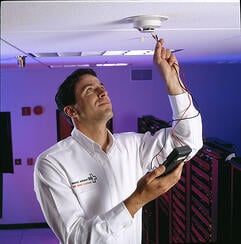Maintaining reliability throughout the entire life cycle of a fire alarm system involves three distinct and equally important tasks which must be performed on a periodic basis: (1.) visual inspections, (2.) functional testing and (3.) maintenance activities. Many overlook the need to visually inspect the fire system and concentrate only on the functional testing of the components. However, each of these tasks are necessary and contribute to the assurance of a fire system that is ready to perform in the case of a fire. Periodic Visual Inspections

A periodic inspection is a visual examination of the equipment to verify that nothing has changed from the initial design and installation that would affect its performance. Those charged with performing an inspection should be looking for a number of conditions which might affect the system’s ability to perform when called upon. A proper visual inspection should consider whether building modifications or occupancy changes would have an impact. A fire alarm strobe light designed and located to disperse light throughout an entire room may now be ineffective due to a reconfigured floor plan. Another important consideration is a change in environmental conditions. Increased cooling systems to support greater heat loads might be producing airflow rates impacting the need to adjust the design spacing of the ceiling smoke detectors. Building owners should also ensure that a visual inspection of the equipment includes identification of changes such as physical obstructions, device orientation, physical damage, degree of cleanliness and any other obvious problem that may not be indicated by the control panel automatically through electrical supervision. A minimum standard for these periodic visual inspections can be found in Table 14.3.1 Visual Inspection Frequencies of the National Fire Alarm and Signaling Code (NFPA 72).
Periodic Testing
Periodic testing is intended to validate the functionality of the fire protection system. Tests are performed by operating each component of the system to assure it performs as required in the case of an actual emergency event. A simple example of this sort of testing is to pull the lever of each Manual Fire Alarm Pull Station to ensure it performs as intended and initiates the required alarm condition. A proper testing program should also include testing the operation of all Emergency Control Functions in the system such as elevator recall or HVAC shutdown. NFPA 72, the National Fire Alarm and Signaling Code (2010 Edition), requires these functions to be tested at the same frequency as the device which initiates the action. For instance, if corridor smoke detectors activate the closure of fire doors, then this function must be tested annually to match the testing requirement of the smoke detector. Beyond just a simple functional test, the test method for many components may also involve the use of calibrated test equipment. One example of this is a duct smoke detector used to control the spread of harmful smoke. A proper test of this device not only must verify smoke will initiate an alarm, but also that the airstream of the ductwork is effectively being sampled. So in addition to the functional smoke entry test for the smoke detector, a pnumometer is used to measure the airflow from the sampling tube. This measurement is then compared to the acceptable range published in the manufacturer’s instructions to determine if the device is performing as designed. A minimum standard for these periodic tests can be found in Table 14.4.5 Testing Frequencies and Table 14.4.2.2 Test Methods of the National Fire Alarm and Signaling Code (NFPA 72).
Maintenance
Maintenance is the work necessary to keep the fire system operating properly. One form of maintenance is simply a response to a failure identified by a visual inspection or a test of the equipment. Service personnel should notify the system owner immediately whenever deficiencies are found during routine inspection and testing procedures. Considering the fact that life safety and/or mission continuity may be at risk, repairs should be made as soon as feasibly possible by qualified personnel. Whenever repairs are not made immediately, a temporary alternative means of protection should be put in place until the fire system is returned to an acceptable level of readiness. Another important form of maintenance is of a preventative nature. Many components in a fire protection system will require preventative maintenance at a prescribed frequency. These maintenance activities address components that degrade over time, have a finite lifespan or require periodic resetting or calibration. For example, most fire alarm systems utilize lead-acid type batteries as a secondary (backup) power supply. Although NFPA codes require routine testing to verify voltage levels are at an acceptable level, a preventative maintenance requirement exists requiring their replacement at 5 years from the date of manufacture. Another important preventative maintenance task involves regular cleaning of smoke detectors. Typically the detector manufacturer’s published instructions will provide both the recommended frequency and method for cleaning, but consideration should be given to adjusting these based on the environment where they are located.
In a survey conducted by the California State Board of Fire Services,1 building owners were asked about the current operational status of their fire systems and about the factors contributing to failures. 73% of the respondents cited a lack of maintenance as the cause for system failures. The truth is a proper inspection, testing and maintenance program will benefit not only in money savings over time, but even more importantly, will minimize an organization’s risk of liability.
1 Source: “Report to the Legislature in Response to House Resolution No. 14, Fire Alarm Systems,” December 30, 1983, Office of the State Fire Marshal, Sacramento, CA 95823.
To make following the inspection, testing and maintenance code requirements easier, we outlined the most common requirements in our brand new Inspection, Testing and Maintenance Guidebook! Use our condensed guide to ensure you are complying with NFPA's required frequencies.





